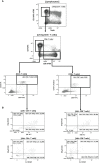Impaired Functional T-Cell Response to SARS-CoV-2 After Two Doses of BNT162b2 mRNA Vaccine in Older People
- PMID: 34868051
- PMCID: PMC8637126
- DOI: 10.3389/fimmu.2021.778679
Impaired Functional T-Cell Response to SARS-CoV-2 After Two Doses of BNT162b2 mRNA Vaccine in Older People
Abstract
Long-term care facility (LTCF) older residents display physiological alterations of cellular and humoral immunity that affect vaccine responses. Preliminary reports suggested a low early postvaccination antibody response against severe acute respiratory syndrome coronavirus 2 (SARS-CoV-2). The aim of this study was to focus on the specific T-cell response. We quantified S1-specific IgG, neutralizing antibody titers, total specific IFNγ-secreting T cells by ELISpot, and functionality of CD4+- and CD8+-specific T cells by flow cytometry, after two doses of the BNT162b2 vaccine in younger and older people, with and without previous COVID-19 infection (hereafter referred to as COVID-19-recovered and COVID-19-naive subjects, respectively). Frailty, nutritional, and immunosenescence parameters were collected at baseline in COVID-19-naive older people. We analyzed the immune response in 129 young adults (median age 44.0 years) and 105 older residents living in a LCTF (median age 86.5 years), 3 months after the first injection. Humoral and cellular memory responses were dramatically impaired in the COVID-19-naive older (n = 54) compared with the COVID-19-naive younger adults (n = 121). Notably, older participants' neutralizing antibodies were 10 times lower than the younger's antibody titers (p < 0.0001) and LCTF residents also had an impaired functional T-cell response: the frequencies of IFNγ+ and IFNγ+IL-2+TNFα+ cells among specific CD4+ T cells, and the frequency of specific CD8+ T cells were lower in COVID-19-naive older participants than in COVID-19-naive young adults (p < 0.0001 and p = 0.0018, respectively). However, COVID-19-recovered older participants (n = 51) had greater antibody and T-cell responses, including IFNγ+ and IFNγ+IL-2+TNFα+-specific CD4+ T cells (p < 0.0001), as well as TNFα+-specific CD8+ T cells (p < 0.001), than COVID-19-naive older adults. We also observed that "inflammageing" and particularly high plasma levels of TNFα was associated to poor antibody response in the older participants. In conclusion, our results show that the COVID-19-naive older people had low counts and impaired specific CD4+ and CD8+ T cells, in addition to impaired antibody response, and that specific studies are warranted to assess the efficiency of SARS-CoV-2 mRNA-based vaccines, as in other immunocompromised subjects. Our study also shows that, despite their physiological alterations of immunity, vaccination is highly efficient in boosting the prior natural memory response in COVID-19-recovered older people.
Keywords: SARS – CoV – 2; T cells response; mRNA vaccination; older people and ageing; vaccine.
Copyright © 2021 Demaret, Corroyer-Simovic, Alidjinou, Goffard, Trauet, Miczek, Vuotto, Dendooven, Huvent-Grelle, Podvin, Dreuil, Faure, Deplanque, Bocket, Duhamel, Labreuche, Sobaszek, Hisbergues, Puisieux, Labalette and Lefèvre.
Conflict of interest statement
The authors declare that the research was conducted in the absence of any commercial or financial relationships that could be construed as a potential conflict of interest.
Figures








Similar articles
-
Cellular and humoral functional responses after BNT162b2 mRNA vaccination differ longitudinally between naive and subjects recovered from COVID-19.Cell Rep. 2022 Jan 11;38(2):110235. doi: 10.1016/j.celrep.2021.110235. Epub 2021 Dec 21. Cell Rep. 2022. PMID: 34986327 Free PMC article.
-
Robust Antibody Levels in Both Diabetic and Non-Diabetic Individuals After BNT162b2 mRNA COVID-19 Vaccination.Front Immunol. 2021 Nov 24;12:752233. doi: 10.3389/fimmu.2021.752233. eCollection 2021. Front Immunol. 2021. PMID: 34899701 Free PMC article.
-
Antigen-Specific CD4+ T-Cell Activation in Primary Antibody Deficiency After BNT162b2 mRNA COVID-19 Vaccination.Front Immunol. 2022 Feb 14;13:827048. doi: 10.3389/fimmu.2022.827048. eCollection 2022. Front Immunol. 2022. PMID: 35237272 Free PMC article.
-
T and B cell responses in different immunization scenarios for COVID-19: a narrative review.Front Immunol. 2025 Mar 18;16:1535014. doi: 10.3389/fimmu.2025.1535014. eCollection 2025. Front Immunol. 2025. PMID: 40170841 Free PMC article. Review.
-
The potential clinical utility of measuring severe acute respiratory syndrome coronavirus 2-specific T-cell responses.Clin Microbiol Infect. 2021 Dec;27(12):1784-1789. doi: 10.1016/j.cmi.2021.07.005. Epub 2021 Jul 10. Clin Microbiol Infect. 2021. PMID: 34256141 Free PMC article. Review.
Cited by
-
Roadmap for Sex-Responsive Influenza and COVID-19 Vaccine Research in Older Adults.Front Aging. 2022 Feb 11;3:836642. doi: 10.3389/fragi.2022.836642. eCollection 2022. Front Aging. 2022. PMID: 35821800 Free PMC article. Review.
-
The impact of frailty syndrome on humoral response to SARS-CoV-2 mRNA vaccines in older kidney transplant recipients.Int Urol Nephrol. 2023 Nov;55(11):2959-2965. doi: 10.1007/s11255-023-03557-6. Epub 2023 Apr 7. Int Urol Nephrol. 2023. PMID: 37027078 Free PMC article.
-
A quest for universal anti-SARS-CoV-2 T cell assay: systematic review, meta-analysis, and experimental validation.NPJ Vaccines. 2024 Jan 2;9(1):3. doi: 10.1038/s41541-023-00794-9. NPJ Vaccines. 2024. PMID: 38167915 Free PMC article.
-
Seroprevalence of anti-SARS-CoV-2 specific antibodies in vaccinated and vaccine naïve adult Nigerians.PLoS One. 2023 Jan 23;18(1):e0280276. doi: 10.1371/journal.pone.0280276. eCollection 2023. PLoS One. 2023. PMID: 36689402 Free PMC article.
-
Immune Responses Against SARS-CoV-2 WT and Delta Variant in Elderly BNT162b2 Vaccinees.Front Immunol. 2022 Jun 27;13:868361. doi: 10.3389/fimmu.2022.868361. eCollection 2022. Front Immunol. 2022. PMID: 35833113 Free PMC article.
References
Publication types
MeSH terms
Substances
LinkOut - more resources
Full Text Sources
Other Literature Sources
Medical
Research Materials
Miscellaneous

